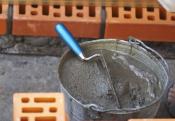Search
Login
Recommended
Methods and methods of water purification in the pool
Water procedures should be not only pleasant, but also safe for health, therefore, the water in the pool should be clean. This article will talk about methods of disinfecting water.
Content
- Methods for disinfecting pool water
- The use of chlorine and chlorine-containing drugs
- Bromine - pool water disinfectant
- Ozone Water Purification video
- Bactericidal properties of silver
- Ultraviolet - a method of disinfection
- Hydrogen peroxide for the pool
Methods for disinfecting pool water
Disinfection of water in the pool is carried out in a reagent, non-reagent and combined way.
The use of chlorine, bromine, azone, silver ions - reagent methods cleaning water.
Water purification by ultraviolet radiation is a reagent-free method of water purification.
When using several methods of disinfection at the same time - this is a combined method of cleaning the pool water.
The use of chlorine and chlorine-containing drugs
The most widespread, when cleaning the pool, was the chlorination of water.
Such popularity is due to the strong bactericidal action of chlorine, as well as its long-term preservation in water.
When chlorine preparations are added to water, active chlorine is released, it is an active adversary of microorganisms.
Hypochlorous acid has the strongest bactericidal property, it is capable of destroying all harmful microorganisms and bacteria in seconds.
The activity of chlorine directly depends on Ph-water.
The higher this indicator, the worse the chlorine-containing reagents work.
For high-quality reagent, the pH should be from 7.4 to 7.6.
Ph is measured in several ways: using a litmus test, a tester in the form of a small container, and portable electronic testers.
The activity of chlorine depends not only on the hydrogen index, but also on nitrogen compounds.
Nitrogen compounds are brought into the pool by a person in the form of sweat, saliva, urine, etc.
Chlorine spends its energy on the oxidation of ammonia and this is a source of chlorine smell, irritation of the skin and eyes.
For complete oxidation of water, shock chlorination is necessary; it is recommended to carry out such chlorination weekly.
To protect chlorine from sunlight, use a stabilizer, usually it is already contained in the reagents.
But the stabilizer does not evaporate, as chlorine does, it gradually accumulates in the pool and causes turbidity of the water.
To eliminate this reason, fresh water must be added to the pool.
Bromine - pool water disinfectant
Bromine, in its actions is similar to chlorine, also has a long-lasting effect, kills all harmful fungi and viruses.
Bromine has an odor, but less than chlorine.
The use of bromine does not cause irritation to the skin and eyes, it is able to work well with a high hydrogen index.
This method of disinfecting water is effectively used in spa pools.
Ozone Water Purification
Such water treatment is especially popular, it is considered promising, since in this way there is a quick disinfection of water.
Ozone can destroy some microorganisms and pathogens that chlorine cannot cope with.
Ozone can purify water from various pollutions and not only contained in water initially in the form of impurities, but also decomposes everything that a person brings into water.
Ozone can be obtained in several ways: by passing oxygen through the reactor, it is subjected to ultraviolet radiation - and this is the easiest way to produce ozone, but inefficient.
Ozone is obtained by the corona discharge method; in this case, oxygen molecules move between the electrodes through an electric discharge and decay to form ozone.
But ozone is a toxic gas, therefore, has a maximum permissible concentration, and this concentration is not enough for complete disinfection, so ozonation is duplicated by another disinfectant.
Bactericidal properties of silver
Silver has bactericidal properties and therefore is used to disinfect pool water.
Silver ions effectively act on microorganisms, penetrate into their cells, remain in water for a long time, and provide long-term disinfection.
But the rate of disinfection is much lower than that of ozone, in addition, silver ions can not destroy all microorganisms.
It is necessary to control the hydrogen index, for more efficient operation, it should be in the range from 7 to 7.2.
Based on the above, we conclude - silver, in the fight against viruses and bacteria, can be used in combination with other disinfectants.
Some spa pools are provided with ionizers, they can produce silver and copper ions at the same time, and if chlorine disinfection is used at the same time, silver and copper ions reduce the amount of chlorine reagent.
Ultraviolet - a method of disinfection
The non-reagent disinfection method has its popularity due to the fact that ultraviolet rays are able to kill all bacteria, while they have a high destruction rate, preserve all the properties of water.
Ultraviolet is easy to use and maintain, it requires a little electricity.
But the disadvantage is that ultraviolet can only work in pure water, without suspended particles, the water obtained after irradiation with ultraviolet does not have bactericidal properties, therefore, it must additionally be chlorinated.
Hydrogen peroxide for the pool
Recently, at the peak of popularity, disinfection of water with hydrogen peroxide is used in small pools.
Hydrogen peroxide, when combined with water, releases active oxygen.
Peroxide can be produced in the form of powder, tablets, granules, liquids, all this is supplied into the water by dispensers.
When using this method, there is no smell, no allergies.
Active oxygen can destroy harmful microorganisms, but the oxidation rate is much lower than chlorine.
Another disadvantage, oxygen radicals are converted into molecular oxygen, which does not have any disinfection.
Again, an additional disinfectant is required. The hydrogen indicator should be 7.2-7.4.





